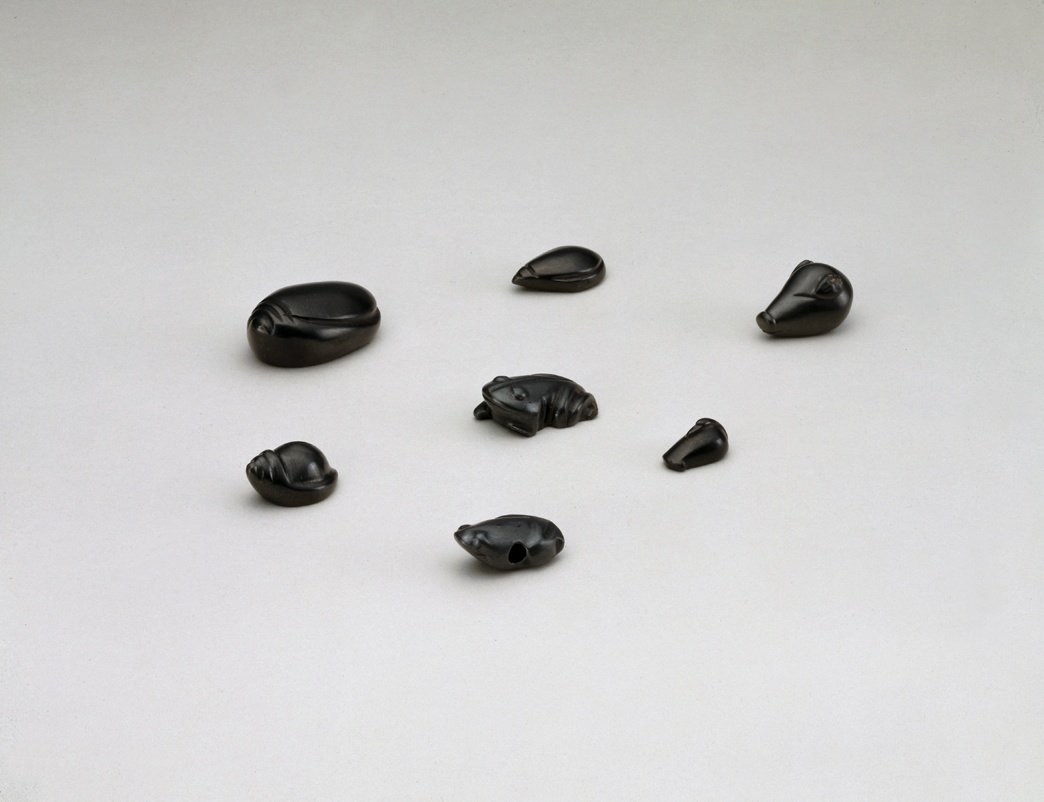
Haematite
Provenance: no indication
Babylonian
First half of the 2nd millennium B.C.
Starting fairly early in the 2nd millennium B.C., a considerable quantity of haematite weights were produced in Babylonia and Susa [1] usually an elongated cylinder of keg shape varying in size and weight. Less common were those in the form of shells, frogs, and ducks with their heads turned back, almost always of well-polished workmanship and a most satisfying plasticity [2]. Highly appreciated in their time, both rare and costly, they also fulfilled the function of amulets and often accompanied their owners in death. In the tomb of Ilsu-Ibnisu of Larsa [3] damaged specimens attest their preciousness and the high esteem in which they were held.
Among examples known to this writer, the squatting baboon is unique and without close parallels. However, there are reproductions of monkeys in various materials, shapes and sizes in the Near East from the 4th millennium onwards, usually represented in the round in stone and alabaster, or on seals. The blocked out execution of this baboon and certain grooves, e.g. the one at the waist, are reminiscent of a squatting monkey [4] in stone, hands raised to mouth, from a foundation deposit of a temple on the acropolis of Susa, though different
as to facial expression and eyes. This parallel is dated c. 3200-3100 B.C., thus suggesting that a long tradition preceded the present weight.
a. Squatting Baboon
Weight: 83.93 g. H: 4.31 cm. W: 2.34 cm. D: 2.8 cm
Condition: hollow eyes once inlaid. Surface smooth with very small nicks here and there. The polish weathered.
b. Shell (gastropod, Olividae family)
Weight: 25.51 g. L: 3.38 cm. H: 1.4 cm. W: 0.8 cm
Condition: intact. Surface highly polished and very smooth.
c. Shell (gastropod, Nassariidae family? Anomaly as laevogyre instead of dextrogyre)
Weight: 6.13 g. L: 2.16 cm. H: 1.3 cm. W: 1.41 cm
Ex collection: Marion Schuster
Condition: minute nicks, fissure on back. Smooth and finely polished.
d. Shell (gastropod, Cypraeidae family?)
Weight: 5.29 g. L: 2.4 cm. H: 0.74 cm. W: 1.42 cm
Ex collection: Marion Schuster
Condition: nick on right side and on left edge and underside. Smooth and finely polished.
e. Frog
Weight: 9.51 g. L: 2.53 cm. H: 1 cm
Condition: left front leg missing. Small nick to hind left foot and under front right foot. Smooth and finely polished.
f. Frog
Weight: 5.23 g. L: 2.15 cm. H: 0.95 cm
Condition: intact save for piercing across centre of body. Smooth and finely polished.
The hole for suspension done in antiquity to enable wearing as an amulet.
g. Boar's Head
Weight: 8.79 g. L: 2.33 cm. H: 1.47 cm
Ex collection: Mr. D'Avray
Condition: intact, save for slight chips to ears. Surface highly polished and very smooth.
h. Duck
Weight: 1.77 g. L: 1.56 cm. H: 0.98 cm
Condition: intact. Highly polished and very smooth.
1 See Belaiew, N.T.: Métrologie élamite, Mémoires de la Mission Archéologique de Perse XXV, 1934.
2 E.g. Paris, Louvre Museum SB 2833, a series of duck-shaped weights in various materials - agate, carnelian, malachite, haematite: Amiet, P.: Elam (Auvers-sur-Oise, 1966), p. 453 fig. 346 B.
3 Arnaud, D., Calvet, Y., Huot, J.-L.: Ilsu-Ibnisu orfèvre de L'E.Babbar de Larsa. La jarre L. 76.77 et son contenu, Syria 56, 1979, fasc. 1-2, p. 24 ff.
4 Paris, Louvre Museum SB 2983: Amiet, P.: op. cit.,
no. 73, p. 115.